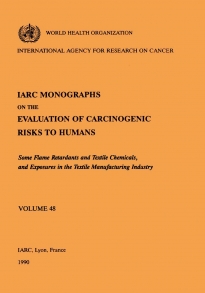
978-92-832-1248-5
978-92-832-0248-6
Evaluates the carcinogenic risk to humans posed by exposure to selected flame retardants and other chemicals used in the textile manufacturing industry. Agents were selected for evaluation on the basis of the availability of data on carcinogenicity and on human exposure. The book also includes an extensive monograph addressing the question of whether employment in the textile manufacturing industry exposes workers to carcinogenic risks. Monographs cover six flame retardants (chlorendic acid, chlorinated paraffins, decabromodiphenyl oxide, dimethyl hydrogen phosphite, tetrakis(hydroxymethyl) phosphonium salts, and tris(2-chloroethyl) phosphate), five textile dyes (para-chloro-ortho-toluidine and its strong acid salts, Disperse Blue 1, Disperse Yellow 3, Vat Yellow 4, and 5-nitro-ortho-toluidine), and nitrilotriacetic acid and its salts. Para-chloro-ortho-toluidine and its strong acid salts were classified as probably carcinogenic to humans; and chlorendic acid, chlorinated paraffins, Disperse Blue 1, and nitrilotriacetic acid and its salts were classified as possibly carcinogenic to humans. The remaining chemicals could not be classified. The most extensive monograph evaluates occupational exposures in the textile manufacturing industry. Evaluations of risk concentrate on epidemiological evidence of carcinogenicity at the oral and pharyngeal, oesophagus and stomach, nasal cavity, larynx, lung, and bladder sites. In view of the strength of findings of bladder cancer among dyers and among weavers and of cancer of the nasal cavity among weavers and other textile workers, the monograph concludes that working in the textile manufacturing industry entails exposures that are possibly carcinogenic to humans.
Flame Retardants
Chlorendic Acid
Chlorinated Paraffins
Decabromodiphenyl Oxide
Dimethyl Hydrogen Phosphite
Tetrakis(hydroxymethyl) Phosphonium Salts
Tris(2-chloroethyl) Phosphate
Textile Dyes
para-Chloro-ortho-toluidine and its Strong Acid Salts
Disperse Blue 1
Disperse Yellow 3
Vat Yellow 4
5-Nitro-ortho-toluidine
Other Textile Chemicals
Nitrilotriacetic Acid and its Salts
Industry
Exposures in the Textile Manufacturing Industry
This volume can be ordered from WHO Press